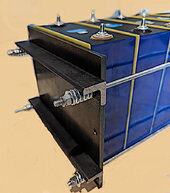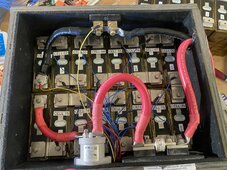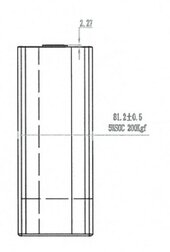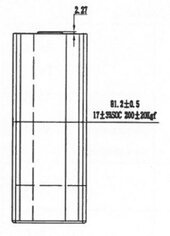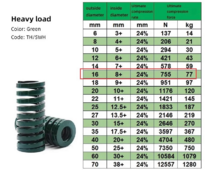I recently purchased a set of EVE LF280K battery cells. I have built similar spring-loaded compression clamps in the past, but the 1/4" steel plate which I used in those boxes would tend to bend around the cells if I used the same "just the plates" approach this time. I also increased the number of clamping rods from four (one per corner) to six (3 per side), so that I could add three cross braces against each plate. Use of 6 springs also allowed me to by smaller springs, with max load only 141 lbs each.
In the LF280K V3 EVE Specification and Testing document, EVE requires battery packs to provide clamping forces between 3000N and 7000N. 3000 Newtons is a bit less than 700 lbs. My travel trailer has very limited room for battery packs, so I chose this spring - it's less than 0.9" tall @ 120 lbs, with solid height .762 @ about 140 lbs. https://www.compressionspring.com/catalog/product/view/s/pc127-625-6000-mw-1060-cg-n-in
It is an expensive one, people with more room can find cheaper alternatives.
The plate height of 8.0" is exactly right for these cells. My purchased width of 9.0" was maybe a bit too much. The rod holes are good with less than 1/4" to the side edge of the plate, so that left a lot room along the sides of cells. (That extra distance tends to increase bending forces within the plates, but I addressed that with these crossbars.)
In this containment, I added three horizontal segments of 90-degree angle bar to the outside of each plate. Each segments are slightly longer than 9.0", with a bit more "beef" outside of the holes for threaded rod pass-thru. The compression springs and nuts are all outside the vertical faces of the angle bar segments, pushing against 1/2" steel (plate plus L-bar) at each hole.
Any attempt at "upward bending" from the middle of the plate pushes against the entire 1" height of the other (non-adacent) angle bar side. An attempt to bend that bar sideways (in the long direction) causes compression along one edge, with tension on the other - and they're held tight by 1/4" steel all the way through.
Unlike my earlier "copmpression boxes" (withouth these cross-bars), the new containment shows zero visible bending after tightening all the nuts. It costs a lot, but in comparison to replacement cells - it's a smart idea.
Photo shows an end plate with 2 cross-bars, 4 rods and 4 springs - the middle row not yet inserted, so you x=can see the holes. Photo #2 is the spring I used. Photo #3 shows one of the angle bar segments, with holes alreasdy drilled to match the corresponding plate. Total for the steel parts swere about $60, and total for the springs was about $50. I spent a LOT of time cutting those holes, but I have only a hand drill - not a drill press, which could run at lower spped and higher pressure. Drill bits added another $15, but i only needed to use 3 of the bits.
In the LF280K V3 EVE Specification and Testing document, EVE requires battery packs to provide clamping forces between 3000N and 7000N. 3000 Newtons is a bit less than 700 lbs. My travel trailer has very limited room for battery packs, so I chose this spring - it's less than 0.9" tall @ 120 lbs, with solid height .762 @ about 140 lbs. https://www.compressionspring.com/catalog/product/view/s/pc127-625-6000-mw-1060-cg-n-in
It is an expensive one, people with more room can find cheaper alternatives.
The plate height of 8.0" is exactly right for these cells. My purchased width of 9.0" was maybe a bit too much. The rod holes are good with less than 1/4" to the side edge of the plate, so that left a lot room along the sides of cells. (That extra distance tends to increase bending forces within the plates, but I addressed that with these crossbars.)
In this containment, I added three horizontal segments of 90-degree angle bar to the outside of each plate. Each segments are slightly longer than 9.0", with a bit more "beef" outside of the holes for threaded rod pass-thru. The compression springs and nuts are all outside the vertical faces of the angle bar segments, pushing against 1/2" steel (plate plus L-bar) at each hole.
Any attempt at "upward bending" from the middle of the plate pushes against the entire 1" height of the other (non-adacent) angle bar side. An attempt to bend that bar sideways (in the long direction) causes compression along one edge, with tension on the other - and they're held tight by 1/4" steel all the way through.
Unlike my earlier "copmpression boxes" (withouth these cross-bars), the new containment shows zero visible bending after tightening all the nuts. It costs a lot, but in comparison to replacement cells - it's a smart idea.
Photo shows an end plate with 2 cross-bars, 4 rods and 4 springs - the middle row not yet inserted, so you x=can see the holes. Photo #2 is the spring I used. Photo #3 shows one of the angle bar segments, with holes alreasdy drilled to match the corresponding plate. Total for the steel parts swere about $60, and total for the springs was about $50. I spent a LOT of time cutting those holes, but I have only a hand drill - not a drill press, which could run at lower spped and higher pressure. Drill bits added another $15, but i only needed to use 3 of the bits.



